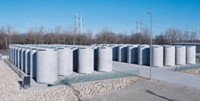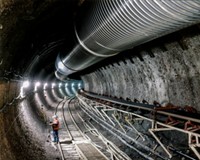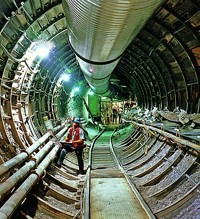Advertisement
Grab your lab coat. Let's get started
Welcome!
Welcome!
Create an account below to get 6 C&EN articles per month, receive newsletters and more - all free.
It seems this is your first time logging in online. Please enter the following information to continue.
As an ACS member you automatically get access to this site. All we need is few more details to create your reading experience.
Not you? Sign in with a different account.
Not you? Sign in with a different account.
ERROR 1
ERROR 1
ERROR 2
ERROR 2
ERROR 2
ERROR 2
ERROR 2
Password and Confirm password must match.
If you have an ACS member number, please enter it here so we can link this account to your membership. (optional)
ERROR 2
ACS values your privacy. By submitting your information, you are gaining access to C&EN and subscribing to our weekly newsletter. We use the information you provide to make your reading experience better, and we will never sell your data to third party members.
Energy
Uranium Plant Gets License
New Mexico centrifuge uranium enrichment plant seen as key to expanding U.S. nuclear power industry
by Jeff Johnson
July 17, 2006
| A version of this story appeared in
Volume 84, Issue 29

Early on a hot Saturday morning at the tail end of June, Sen. Pete V. Domenici (R-N.M.) took a phone call at his home on Capitol Hill. On the line was Nils J. Diaz, the head of the Nuclear Regulatory Commission (NRC), who reported that late the day before, the commission had licensed the first large U.S. nuclear project in nearly 30 years, an approval of great importance to the senator.
Diaz was referring to a $1.5 billion gas centrifuge uranium enrichment plant, a project Domenici badly wants both because of the new jobs expected to come to his state and because the project is a linchpin in his drive to revitalize the U.S. nuclear power industry. The plant will enrich, or concentrate, low levels of fissile U-235 in natural uranium to amounts needed to fuel commercial nuclear power plants. It is to be built in the rural southeastern corner of New Mexico, and along with being a top priority for the senator, who chairs the Senate Energy & Natural Resources Committee, the plant is sought by the nuclear power industry and the industry's regulator, NRC.
Recalling the phone conversation, Domenici said, "It was the voice of this gentleman here," pointing to Diaz at a June 28 celebration, held in Senate chambers jammed with project supporters. "He offered no apology for disturbing me on a Saturday," Domenici said. "He was clearly on a high. He wanted to tell me the extremely important date that it was and that NRC had in fact licensed the National Enrichment Facility for Lea County. He wanted to make sure I knew it was done in a timely manner."
The early morning wake-up call, Diaz said, was "revenge" for the long years of congressional and industry criticisms of NRC for failing to quickly process license applications. In a statement, the Nuclear Energy Institute, a trade association, said it too was pleased and noted that NRC had made a 30-month self-imposed processing target that "bodes well for the construction and operating licenses applications for new nuclear power plants."
Timing was also singled out for frequent applause and accolades during the Senate celebration, which drew a host of Lea County officials, most of the New Mexico congressional delegation, and top nuclear industry officials, as well as officers of Louisiana Energy Services, the planned enrichment plant's owner and operator. LES is a consortium of foreign interests, led by European firm Urenco, which is composed of British Nuclear Fuels Ltd., the Dutch government, and several German nuclear utilities. Urenco operates three plants similar to the one intended for Eunice, N.M. In all, Urenco fills about 20% of the world's enriched uranium needs for commercial power plants.
Construction at Eunice will begin in August, says Jim Ferland, LES president and chief executive officer, with production to start in 2008 and full capacity expected in 2013. When operating at top capacity, Ferland says, the facility will supply one-quarter of current U.S. needs.
"We've already sold about 80% of the first 10 years' production," he says. "We built our business plan on current demand and the assumption there will be no new nuclear plants in this country."
The project has critics, however, who challenge NRC's approval process and worry that Diaz and the other commissioners are putting their pronuclear views ahead of their responsibility as regulators.
Diaz's phone call "shows how politicized the licensing process has become," says Arjun Makhijani, a physicist and president of the Takoma Park, Md.-based nonprofit Institute for Energy & Environmental Research. IEER, the Nuclear Information & Resource Service, and Public Citizen challenged the plant during the NRC approval process. Their biggest concern is the fate of thousands of tons of depleted uranium waste that will be generated by the new enrichment facility.
They argue that NRC did not clearly set out how LES must handle the waste: depleted uranium hexafluoride. Eventually, they say, the plant's waste could join a huge quantity of similar waste generated by the government since the 1950s.
They have reasons to worry. The U.S. has produced some 700,000 metric tons of depleted UF6 held in 12-ton canisters stacked in long rows at several government facilities. A few years ago, the Department of Energy broke ground on construction of two treatment plants to process this waste. But neither is completed, and if the plants meet their most optimistic schedules, it will take them a combined 43 years to process the DOE waste.
LES intends to build its own chemical plant to treat the waste at the New Mexico site, Ferland says, but he adds that under the NRC license, the company can turn the waste over to DOE. A final decision has not been made.
The significance of this was not lost on New Mexico Gov. Bill Richardson, a former DOE secretary. He worked out a side deal with LES that puts a cap of 60,000 tons for on-site storage of depleted uranium. When the cap is reached at Eunice, the waste must leave the state. The deal is court enforceable with penalties of at least $5,000 per day. Critics in New Mexico underscore the deal's importance by pointing north to Nevada and DOE's Yucca Mountain repository for an example of a failed nuclear waste project. Although depleted uranium is much less radioactive and toxic than the high-level radioactive waste intended for Yucca Mountain, there is 10 times more of it.
The process of concentrating U-235 is essential to the nuclear fuel cycle. Natural uranium is mostly U-238, with a very small mix of other uranium isotopes and 0.72% fissile U-235, which is needed for nuclear fuel to begin reacting and to maintain nuclear fission. To get uranium to split and release thermal energy, it needs to be enriched to 3-5% U-235.
The enrichment process takes advantage of the slight difference in atomic weight of U-235 and U-238. Both of today's enrichment technologies, gaseous diffusion and centrifuge processes, begin when uranium hexafluoride, made from uranium ore, arrives in a solid form at the enrichment facility. Both processes start by converting UF6 to a gas.
Diffusion forces the gaseous UF6 through hundreds of porous membrane barriers slowly separating the lighter U-235 from heavier U-238. The enriched UF6 with higher concentrations of U-235 is cooled, solidified, packaged, and transported to fuel fabricators. Centrifuge technology uses rotating cylinders spinning at high speeds to separate the isotopes by driving UF6 gas with the heavier U-238 against the cylinders' walls and gas containing the lighter U-235 toward the cylinders' centers. The UF6 with higher concentrations of U-235 is withdrawn and moved to cascades of additional rotating cylinders, enriching the UF6 until it reaches the proper concentration.
Centrifuge-based technology is the wave of the future. It uses about 5% the electricity of diffusion and is able to concentrate U-235 much faster. It has been used for 30 years outside the U.S.
It is also the technology used by the Iranians to enrich uranium, an effort that has been criticized by the U.S. and other Western nations. This is because by moving the uranium to more and more cascades, U-235 enrichment can reach the 85% or more needed for a weapon. The International Atomic Energy Agency has suggested putting all enrichment globally under international controls. Nonproliferation issues were not addressed in the NRC proceedings.
The U.S. has one operating enrichment facility, owned by the U.S. Enrichment Corp. (USEC) and located in Paducah, Ky. It was originally government owned and operated, producing highly enriched uranium for bombs as well as fuel for power reactors. It was turned over to USEC in 1998.
The Paducah plant uses gaseous diffusion, but USEC also plans to build a centrifuge plant. It has received an NRC license to build a demonstration centrifuge facility at Piketon, Ohio, and has an NRC application pending to build a full-scale commercial enrichment facility, also at Piketon.
The USEC facility will be slightly larger than the LES facility. Together they will produce more than half the enriched uranium needed for today's U.S. nuclear power plants. Despite these plans for new U.S. enrichment facilities, Ferland says, "there is plenty of room in the U.S. market. Nuclear power fuel should be supplied domestically. Otherwise, we are dependent on outside sources."
At this time, about 10% of U.S.-enriched uranium is produced by USEC's gaseous diffusion process, about 25% comes from Urenco's European operations, 21% is provided by the French company Cogema, and another 44% comes from the "megatons to megawatts" program.
The megatons program was created in the 1993 nonproliferation agreement between Russia and the U.S., in which some 500 tons of nuclear-bomb-grade, highly enriched uranium—equivalent to 11,000 warheads—is down-blended to lowenriched nuclear fuel for U.S. power plants. So far, 275 metric tons has been converted to power plant fuel.
"These new plants will remove any incentive to down-blend bomb material from weapons," Makhijani warns. Because there remains so much excess bomb-grade uranium, he argues, there is little need for new enrichment facilities in the U.S.—on nonproliferation grounds alone.
But most of Makhijani's concerns are reserved for what is to be done with the depleted uranium waste, or more accurately, the depleted uranium hexafluoride. UF6 is highly corrosive and slightly radioactive. To treat it, steam and hydrogen are added to the depleted UF6 to produce hydrogen fluoride and uranium oxides. The result is an aqueous hydrofluoric acid by-product that may be sold and uranium oxides that NRC has defined as waste that would go to a low-level radioactive waste landfill.
This is the process LES is considering using at the New Mexico plant, and it is the treatment and deconversion technology being built at the two DOE plants in Portsmouth, Ohio, and Paducah, says Doug Adkisson, vice president and operations manager for Uranium Disposition Services, the DOE contractor that is constructing and will operate the facilities.
Adkisson says the construction should be wrapped up next year and operations should begin in 2008. To treat the backlog of 700,000 metric tons of UF6, the Portsmouth plant will run for 18 years; Paducah, for 25 years. Any plan to add the LES waste to this schedule must be negotiated by DOE and LES, he says.
Yet the NRC license and LES business plan assume that DOE's future plants will be the backup to treat the additional depleted uranium. NRC relied on DOE's cost estimates to determine the expected treatment costs for LES's operations.
Makhijani objected in testimony and a petition to NRC, saying DOE cost estimates are historically inaccurate. He worries that if DOE lowballed the cost estimates, and the cost of treatment turns out to be much higher, the company may fold, and LES's waste will wind up in one more taxpayer-funded cleanup program.
The eventual cost also may turn on NRC's decision to define the depleted uranium as a waste that can be put in a landfill in a low-level radioactive waste facility. Makhijani believes the eventual radiation dose to individuals from landfill-deposited uranium oxide is too high and that NRC's determination will not hold up under legal challenge. The waste, he says, then will eventually go to a deep-underground repository, greatly increasing disposal costs.
But when you listen to community leaders in Eunice, a very different perspective of the project emerges, a view not lost on political leaders.
Eunice was LES's third choice for a home. The company first sought to build a centrifuge enrichment facility in Homer, La., in 1991 but withdrew its application in 1998, when it faced litigation over environmental justice issues relating to the site's location between two rural minority communities.
LES then explored a site in Tennessee but dropped that effort due to local opposition. It then turned to New Mexico, largely as a result of urging from Domenici, NRC and LES staff members say.

"A booming economy—that is what we get out of this deal," says Eunice Mayor Matt White. "Our little town is built on an oil field," he adds, describing years of economic swings driven by oil price volatility.
Advertisement
"Once our little city was up to 5,000 or 6,000 people, but right now we are down to 2,400. This year alone, we anticipate gaining about 1,000 new residents just from the LES plant. And they are talking about building a couple other facilities to handle the waste. So we are looking at another 400 or 500 permanent jobs."
LES, he says, has donated $1 million to upgrade the city's water supply to the level needed for the plant and some $50,000 for the fire department. Excel Energy has increased the town's and company's electrical service. But because of the state's limits on how much waste can be stored on-site, White hopes a waste storage facility might be built in Texas, which is just five miles away. LES has also established funding for a city foundation and has put in $30,000 with promises of more to come. An LES official says the company is urging construction firms to cough up more funds for the foundation.
"We are going to have an enormous impact on this community," says Marshall Cohen, LES vice president for communications, "and we want it to be a good impact. We will help the community with safety and education and do things that might not otherwise happen there."
"Oh, the city is excited about all this," White says.
LES's opponents have appealed the NRC decision on LES, but this train is on a very fast track.






Join the conversation
Contact the reporter
Submit a Letter to the Editor for publication
Engage with us on Twitter